Post Mortem Black Hole
- Roy Fry

- Nov 2, 2021
- 9 min read
The Black Hole Project completed (Week 7 Blog 1)

During the Black Hole Project, we had to replace all the sounds of the short film and then start creating our own interpretation of sounds to coincide with the short film. The sound designs had to be believable so that the audience can follow the story and with the new audio sounds capturing their imagination.
Create a believable contract to submit to the would-be client.
During week 2 of the project, we booked the Foley Studio C24 out for week 3 so we could get all the foleys done at once and try to create a little buffer zone. We wanted to have some space to make small adjustments along the way and a makeup time plan for if any problems occur later on. Just as if we were applying for funding

For project administration, monitoring and reporting (project updates)
We created a shared dropbox that everyone could link to via google drive.

We all had to submit our roles in the project and responsibilities.
For the team to have constant communication, we created a Slack channel and a Skype video group site. Our main communications for this project was done on the slack network.
First step week 2 / The Black Hole Project Team
During week 2 of the project, we booked the Foley Studio C24 out for week 3, so we could get all the foleys done at once and try to create a little buffer zone. We wanted to have some space to make small adjustments along the way and a makeup time plan for if any problems occurred later on.
In anticipation of the project being approved, We used Pro Tools as the DAW for this project. We started marking every movement the character made on the Pro Tools timeline, by hitting the short cut key on the numeric side of the keyboard, which is the key command enter on the bottom right side of the numeric keypad. We did this prior to the contract being approved, as it would cut down a lot of time while we were waiting to have the contract looked over by the client, plus this would give us a good start. Then we started entering names at all of the positions we had marked as memory location reference points.
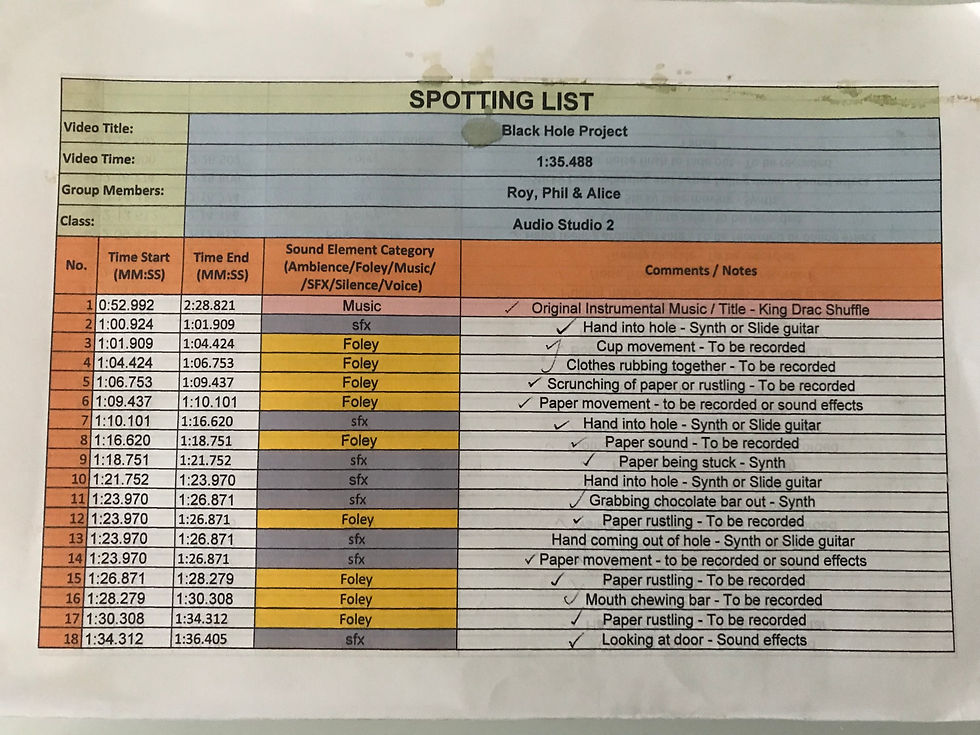

As we were creating our memory locations, we also put some thought into how we were going to create the sounds and if it needed other ambiance sounds as well, that would give the short film a more believable feel about it.
l composed a little 12 bar boogie to go with the clip. a simple instrumental using an electric guitar, bass guitar and a programmed drum kit, in EZDrummer, the idea was to book a studio and have Phil to come in and replace the program drums with him playing the drums live. I presented the instrumental to the team and we all agreed that our time would be better spent, leaving the drum program in and concentrating more on the sound design aspects of the project.

Week 3, our project was formally approved. So the work we put in during week 2 prior to the contract signing, (like the soundtrack being completed and the memory locations as a guideline) we used to replace the foleys and sound design. This was well spent and we were off to a good start.
We booked C24 studio for an 8 hr session and we created all of the foleys that we thought were needed by the end of the day.
The microphones we used are

We used the NTG-1 mainly as the main microphone. This microphone has been designed to filter out surrounding sounds and capture the sound it is directed at, so we were able to record our foley sounds with a crisp clean signal, without any sounds filtering through from the background.
The Rode NT2A condenser microphone, we used as the room microphone. I think we left the microphone set on cardio and the other settings on zero, as we wanted to blend the 2 microphones together for our foley sounds.

We used every inch of the room to create our foley sounds, from creating a wind noise through moving a plastic pipe, plucking the pinecone, shuffling feet and knees on the carpet in the control room, Phil created floor noises by using 2 pieces of foam and laying a tea towel over the top, then moving his hands over it to give the impression of feet moving on carpet.

We recorded the air duct to get the sound of the air conditioner noise to recreate an office room ambiance. At the front door to the studio, we recorded the hinges and the door lock jam being opened, also the computer noises to bring more realism into the clip from the control computer room.
For the Light switch sound.
we made buzzing sounds with our mouths, pluck the pinecone, scrapped fingernails on a cup, tapped an aluminum flask to get a switch shorting noise. Trying to get that realistic flickering noise, so when you see the character turning on the switch it sounds real. I ended up using 8 audio tracks and 15 plug-ins all combined together to create the noise l was after.

Also for the light switch sound, I had to shorten some of the transients in the clips and increase the dB levels in the clips to get them to sound right and stagnated the audio clips so it would give it more of a lifelike sound.
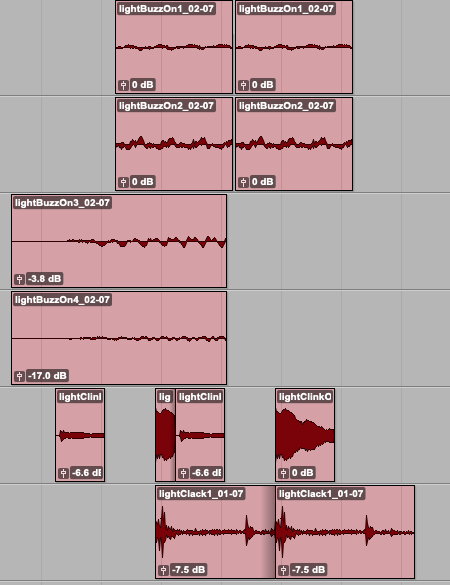
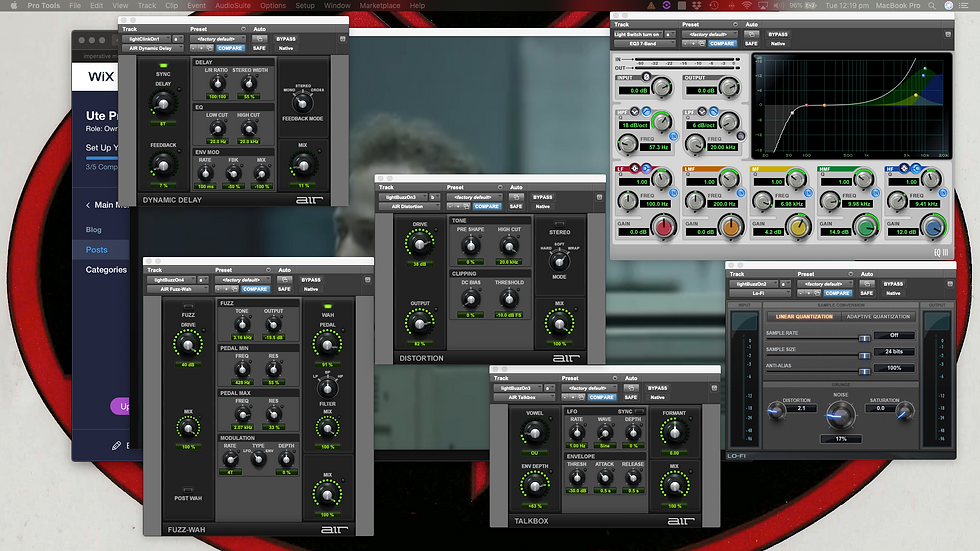
We used a combination of sounds to create all the light switch noises.
How we created the Alien sound.
To create the alien noise and make it sound believable (for the hand gestures) was also difficult to achieve. We recorded Phil blowing into the top of an aluminum drinking flask, Phil making groaning noises, the foley sliding door opening, Phil added a keyboard sound and found an online sample to add. Once we were all happy with the mix of the tracks together for our sound, we recorded the mix into 1 stereo track. We ended up using another windpipe audio track to blend into the mix.
We also used the TCE (Time Compression/Expansion trim) to try and give the clips a spooky alien feel about it, by stretching the wav transients in and out. We reversed the transient clip when our character was pulling out his hand. We added a couple of plug-in effects to our alien sound, equalizers plus a talk box.
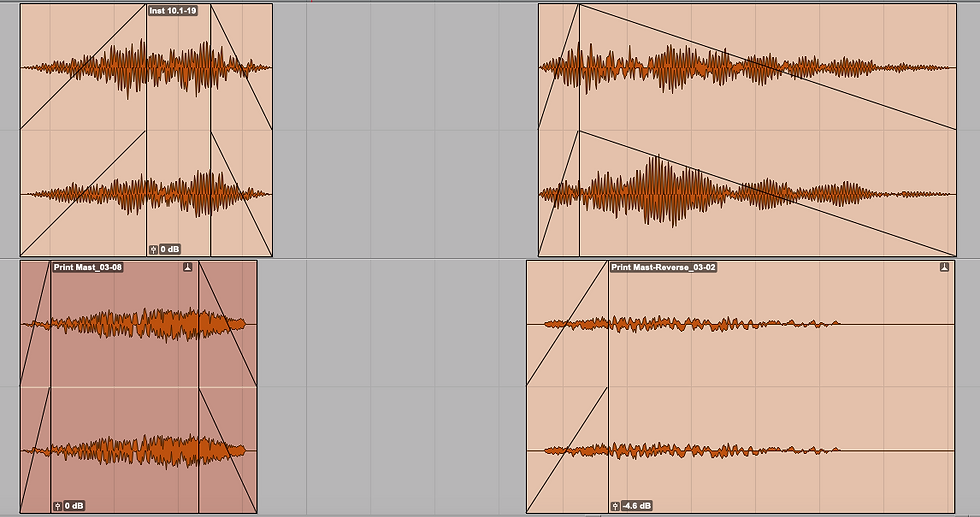

As we were coming towards the end of the foley sounds and sound design, I edited the instrumental track so the music would come into the scene when our character opens the door to get to the safe. I wanted the music to sound like it was coming from a radio or outside of the room and not interfere with the storyline or grab the attention of the audience as they were watching what the character was doing, as he moved towards the safe.


EQ settings for the music radio sound effect were by filtering the low and high band frequencies and slightly increasing the 1k frequency gave it the radio effect.
I didn't have to use a very heavy compression setting, just enough to keep the dB level meter from spiking dramatically.

Radio effect link below
Reflection and recap on project
I feel the Black Hole Project went reasonably well. We viewed our project as a professional practice and treated each other in a professional manner. We created a Slack account for this project and the team members were able to communicate through Slack pretty successfully. I set up a Skype group account, to see if it was going to suit our project as another form of conference link-up. I really like Skype because you can communicate directly to your team members live and in person and this method of communication would probably create a quicker workflow.
The only communication breakdown was when we couldn't get hold of Alice for a couple of days. Alice was sick with the flu and we were trying to get hold of her for some input about the project. We talked about how we can improve our team communication platform. l just asked if we all could keep in contact with each other. (Phil and l were a little worried about her welfare)
The studio sessions went pretty smooth and we managed to keep the recording workflow at a reasonable pace in the Foley Studio C24. It was good to be able to use other studios during class time for project update sessions, (even when a member of the team couldn't attend). The other members of our team covered the additional workload without any fuss, and by doing this we were able to stick pretty close to our milestones and deadlines. I take on board that if a team member hasn't got time to complete what they are doing, then l have no problem helping out to get the job completed.
Our milestone planner worked pretty well, and we were able to keep on track until virtually the end when we let the soundhole hand movement get away from us. Redoing foleys can be quite challenging and can cut into the team's milestone time table, big time. We should have taken care of this foley in week 3, we left it to the last minute to do. At week 5 l was expecting to start sorting out the mix and have the project mix ready for presentation, but we had to work on the alien foley sound to complete all the sounds. On reflection of our milestone planner, we did manage to keep to most of our milestones in check.
Our execution of this project went pretty good, Phil, Alice, and l were for most of the time making sure that the milestones that we had set, were being met. I was mentally ticking them off and trying to keep my side of the workload up to date.
I think we did pretty good, we met most of the facilitators' product output briefs, but there were areas that could have been a lot better. For example, the alien sound was sounding too much the same and it needed pitch variation on the sound, but it still gave the illusion of the character's expression and wonder of the possibilities on what the character could achieve, even though he was skeptical about the black hole. After we presented our first mix and received feedback on how we can improve our mix and what areas to look closer at, I went home and worked on the mix in accordance with the briefs suggestions. These were placed in our work log feedback section and I made the appropriate changes that had been suggested to the best of my abilities at this time, and to make improvements for the final mixing outcome.
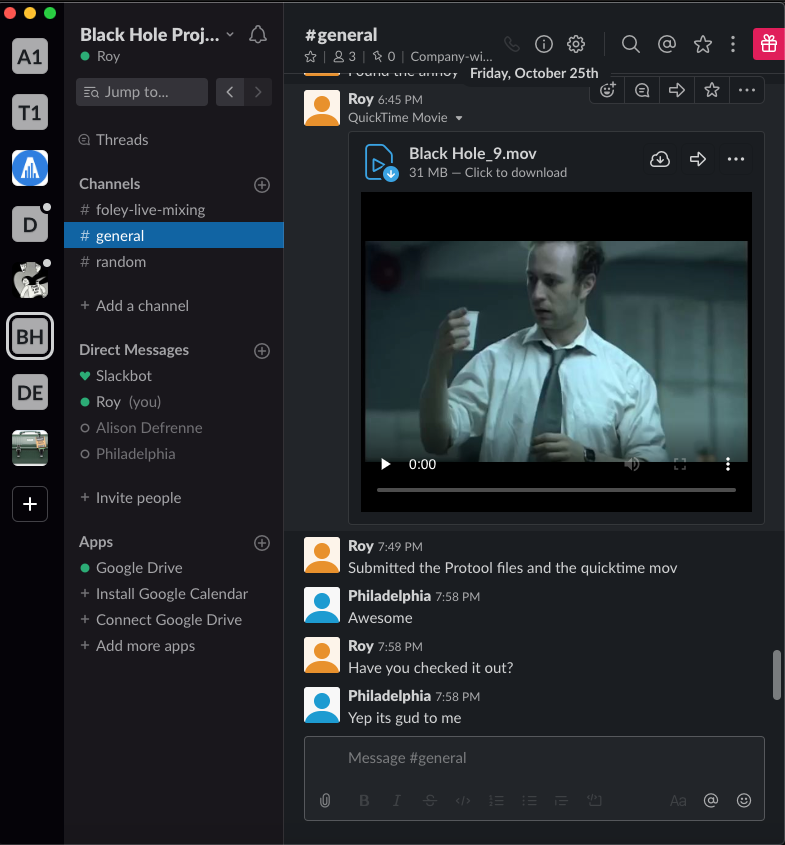
I also uploaded each version of the mix l altered onto the Black Hole Project Slack channel into the general section, so the other team members could view and hear the mix. This would give them the opportunity to respond, and also for me who is representing the team, to make any changes they felt were required for a better product.
When it came to researching for different applications we could use, we talked as a team and we allocated different roles for each team member to research. Mine was trying to get the light switch to sound right, and another was to shorten the original track and make the music part of the ambiance, along with having it being mixed right in the background, like a radio effect, and so it didn't interfere with the main soundtrack of our short film.
What did l learn from this experience?
I learned just how creative you have to be when you are working with other disciplines.
The amount of work and time that is required to mimic or duplicate a sound is amazing.
The creative process you can apply to get a realistic sound that will help to bring a film project to life.
Conclusion
I have really learned a great deal from completing this project. and being able to experience how the audio engineer fits into the film or animation industry was brilliant. Learning foley, sound design and ADR was great. Now when l watch a movie or anything on TV, l find myself checking out how they have created, or put together their audio sounds and where they have placed the sounds in the speakers compared to the visual aspects of a scene.
Sometimes l found it a little frustrating if the team made a plan to do a milestone objective, and then the plan was altered at the last minute. l personally need to plan smarter and learn different techniques to handle spontaneity to enable any unforeseen last-minute problems that may occur. I also have to learn to have backup plans (a & b) that can be implemented quickly and can be just as beneficial to the team's project. Quick problem-solving could have helped us in making it possible to get through the milestones quicker. Thinking smart makes work quicker.
Originally our presentation was a real disaster because our team had never really dealt with films in Pro Tools. We did touch on it in trimester one however I just didn't realize the steps we had to do to record the project into the Quicktime format in Pro Tools. That became a big learning curve for me as I personally was unsure about what I was doing. However as a team, we worked pretty well together, everyone was there when we needed a team effort and even though we had minor setbacks here and there, we were still able to create a reasonable standard for the product with our own sound replacement.
This whole experience I found a light bulb moment, leading to me now, watching TV and movies through a different lens and it has created a high appreciation of skills required.
References
How To Do The "Radio Effect" In Protools. (2014, January 23). Retrieved October 30, 2019, from https://youtu.be/pPyjcCoDuyg.

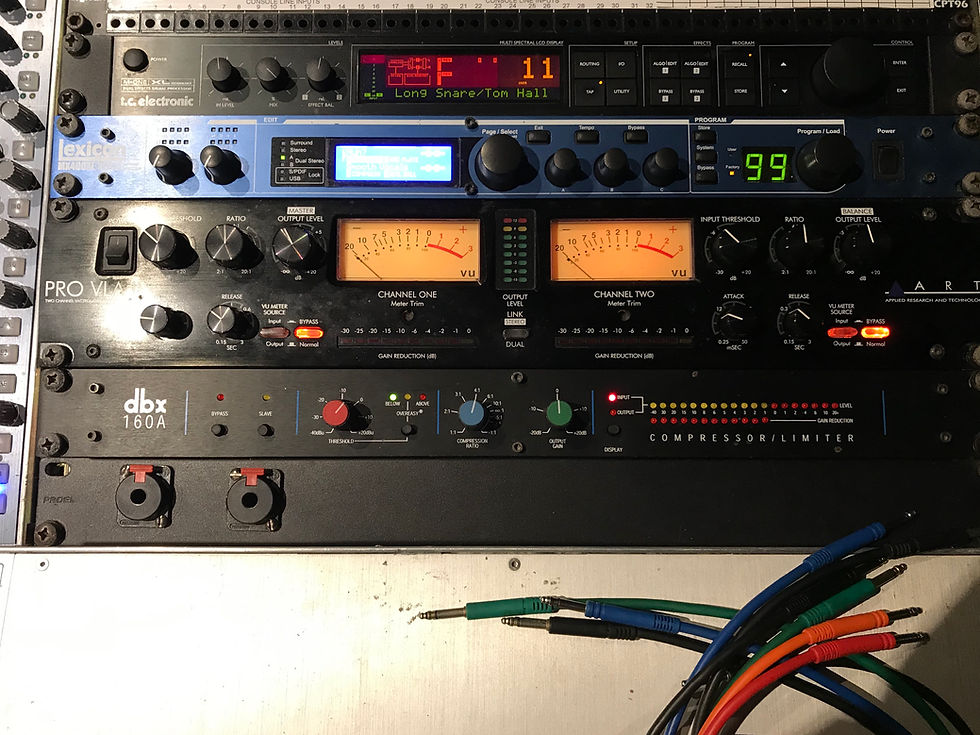

Comments